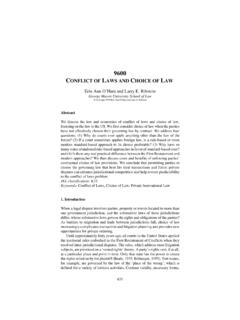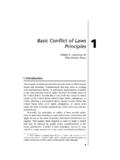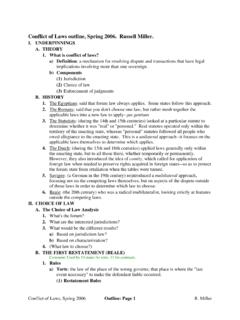Transcription of BASIC CONCEPTS AND POLICY CONCERNS 1 TRADITIONAL ...
1 conflict of laws Kay Fall 2009 29 BASIC CONCEPTS AND POLICY CONCERNS 1 TRADITIONAL approaches 1 vested rights approaches (BEALE) 1 Place of Wrong Rule for Torts 2 Definition of place of wrong 2 Contracts 3 Validity 3 Performance 4 Property 4 Marriage 4 Family Law 4 Escape Doctrines 5 Recharacterization 5 Substantive / Procedural Distinction 5 Renvoi 6 Public POLICY Exception 6 Penal Law 6 MODERN approaches 7 Statutory Solutions 7 Choice of Law Contract Provisions 7 Interest Analysis (Currie) 8 Analytical Method 8 (1) Decide which state s interest to examine (p129) 8 (1) Determining a State s Interest ( 8 Is this a False, True Conflict or unprovided for?)
2 9 approaches for True conflicts 10 NY Approach: 10 Currie s Approach: Government Interest 11 California Approach: Comparative Impairment (Baxter) 11 conflict of laws Kay Fall 2009 30 Principles of Preference (Cavers) 12 Most Significant Relationship Test (Second Restatement) 13 Center of Gravity Approach 15 Better Law Approach (Leflar) 15 Application of Different laws to Different Elements (Depecage) 16 Choice of Law in Complex Litigation 16 CONSTITUTIONAL LIMITATIONS OF CHOICE OF LAW 17 Early approaches 17 New Deal approaches 18 Modern approaches 18 Obligation to Provide a Forum 18 JURISDICTION OF COURTS 18 General Jurisdiction 19 Specific Jurisdiction 19 Factors 19 Claim Must Arise out of Contacts Factor 19 Purposeful Availment Factor 19 Stream of Commerce Theory 20 Purposeful Direction Theory 20 Reasonableness factor 21 Public Factors (p437, n.)
3 6) 21 Private Factors (p437, n. 6) 22 What Law will Apply 22 RECOGNITION OF JUDGMENTS 22 BASIC Rule: 22 Determinations of Jurisdiction 23 Land Taboo 23 Modifiable and Non-Final Judgments 24 DIVORCE 24 conflict of laws Kay Fall 2009 1 conflict of laws REMEMBER: (1) Before Applying any state s law, considering whether the constitution ALLOWS them to apply it. ( Dick Problem ) BASIC CONCEPTS and POLICY CONCERNS I. POLICY CONCERNS a. Forum Shopping i. The TRADITIONAL approaches better control forum shopping than the modern approaches II. Domicile Definition (White v. Tennant, p 30): a. Where you intent to remain indefinitely or where you may intend to remain for a time being i.
4 If abandon old domicile and die before acquiring a new one (r1d approach) 1. Majority Approach: Acquire new domicile upon abandonment 2. Minority Rule: home domicile is reestablished if not acquired a new domicile ii. Second Restatement approach: must be physically present to acquire a new domicile (p34, ) III. Proving Choice of Law (p 84 90) a. Common law courts treated foreign law as a fact that needed to be pleaded and proved (p87, ) b. Many states now allow judges to take judicial notice of a foreign law and allows the court to call in experts to help learn what the law is TRADITIONAL approaches I. BASIC Concept a.
5 The TRADITIONAL approaches are bright-line rules in applying choice of law i. The courts do not look at the content of the law until the very end to utilize the public POLICY exception (jurisdictional selecting approaches ) 1. The POLICY choices of the various states do not matter b. vested rights approaches (Beale) i. When an event occurs giving rise to a claim, it vests the person with certain rights based on where events occur. These are transitory rights that can be taken into another state and sued upon ( CONCEPTS /Insights pg 4) conflict of laws Kay Fall 2009 2 1. Therefore the forum court simply enforced the right which had vested in the foreign territory 2.
6 Every legal occurrence has a unique location, the place where the rights vest ii. Cook s Critque: 1. This is not an accurate description of what courts actually do 2. Courts really are applying forum law, but they may borrow elements from sister states c. Advantages (p10, ): i. Uniformity ii. Predictability iii. Protection of Expectations d. Problems: i. Create unfair results 1. Courts created escape hatches that then swallowed the rules ii. Depending on characterization of problem (tort, contract) II. Rationale: a. Protect the Sovereignty of each state (p 10, ) i. Huber s Maxims (p3) 1. Each State s law stops at its borders 2.
7 Entering the state makes you subject to that state s law 3. Under principles of comity, sometimes a state can retain power if they don t cause prejudice to the sovereignty of another state (Public POLICY Exception) b. Because of sovereignty, the law of each state cannot reach outside its own borders III. Place of Wrong Rule for Torts (p14 17) a. Rule: i. The state where the place of wrong occurred is the law that governs (Alabama Great Southern v. Carroll ) 1. Railroad, injury occurred in Miss, negligence occurred in AL everything but the injury pointed to AL but court applied Mississippi law because that was place of injury 2.
8 Shows the occasional arbitrariness of the place of wrong rule b. Definition of place of wrong i. Localization process: localize place of wrong into a particular jurisdiction and that jurisdiction s law will apply ii. Beale s Approach (p14) conflict of laws Kay Fall 2009 3 1. Place of wrong is the place where the last event necessary to make an actor liable for the alleged tort took place a. Exceptions (p15, ): i. If place of wrong depends on the application of a standard of care, then it should be taken from the place of the actor s conduct ii. If a person is required, forbidden or privileged to act under the law of a place of acting, then should not be held liable for consequences in another state iii.
9 Libel (p16, ) 1. Place of wrong is where the defamatory statement is communicated iv. Privacy (p16, ) 1. Place of wrong is whether the plaintiff was when his feelings were wounded (Bernstein v. NBC) v. Poison (p16) 1. Place where the poision takes effect on the body, not where the plaintiff dies vi. Wrongful death ( CONCEPTS /Insights p 7) 1. The location of first illness, not the place of death (same as the poison rule) c. Pros i. Posner (p17., ): 1. Place of wrong approach will reflect community values better d. Critiques i. Carver (p15, ) 1. Place of Wrong rule assumes that only one jurisdiction is the source of a law in a given case) ii.
10 Cook: Local Law Theory (p13) 1. State is only an agent for appling its own state laws IV. Contracts a. BASIC Rules (R1d 332 p 21): i. Validity of the Contract is determined by the place it was made (Milliken v. Pratt p 17) 1. Contract is made whether the contract was accepted (p19, p24 ) 2. Also covers (21): a. Capacity to make a contract b. Necessary form in which the promises must be made c. Mutual assent or consideration conflict of laws Kay Fall 2009 4 d. Promises to make K binding e. Fraud, illegality or anything that makes promises void f. the time and place where the promise is by its terms to be performed g.









